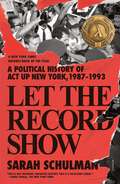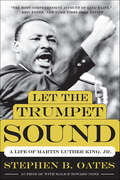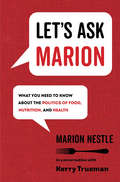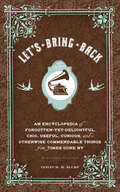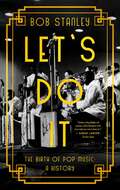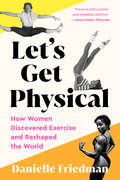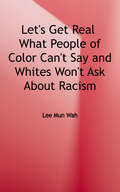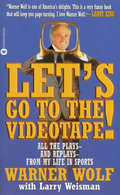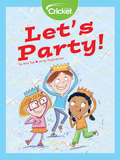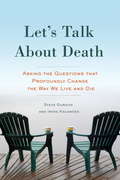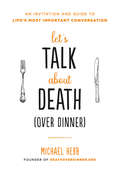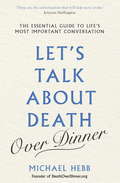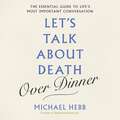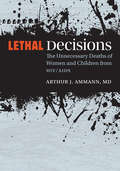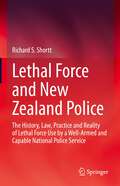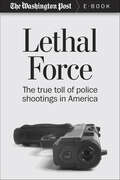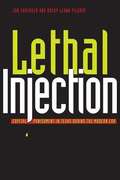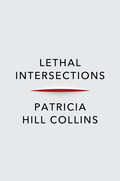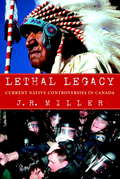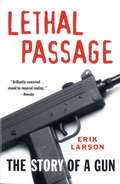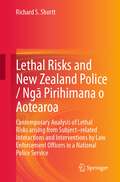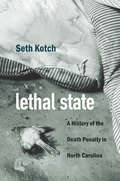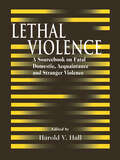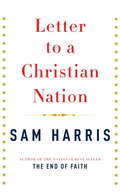- Table View
- List View
Let the Record Show: A Political History of ACT UP New York, 1987-1993
by Sarah SchulmanA New York Times Book Review Editors' Choice. "This is not reverent, definitive history. This is a tactician’s bible." --Parul Sehgal, The New York Times"A masterpiece of historical research and intellectual analysis that creates many windows into both a vanished world and the one that emerged from it, the one we live in now." --Alexander Chee Twenty years in the making, Sarah Schulman's Let the Record Show is the most comprehensive political history ever assembled of ACT UP and American AIDS activism In just six years, ACT UP, New York, a broad and unlikely coalition of activists from all races, genders, sexualities, and backgrounds, changed the world. Armed with rancor, desperation, intelligence, and creativity, it took on the AIDS crisis with an indefatigable, ingenious, and multifaceted attack on the corporations, institutions, governments, and individuals who stood in the way of AIDS treatment for all. They stormed the FDA and NIH in Washington, DC, and started needle exchange programs in New York; they took over Grand Central Terminal and fought to change the legal definition of AIDS to include women; they transformed the American insurance industry, weaponized art and advertising to push their agenda, and battled—and beat—The New York Times, the Catholic Church, and the pharmaceutical industry. Their activism, in its complex and intersectional power, transformed the lives of people with AIDS and the bigoted society that had abandoned them. Based on more than two hundred interviews with ACT UP members and rich with lessons for today’s activists, Let the Record Show is a revelatory exploration—and long-overdue reassessment—of the coalition’s inner workings, conflicts, achievements, and ultimate fracture. Schulman, one of the most revered queer writers and thinkers of her generation, explores the how and the why, examining, with her characteristic rigor and bite, how a group of desperate outcasts changed America forever, and in the process created a livable future for generations of people across the world.
Let the Trumpet Sound: A Life of Martin Luther King, Jr.
by Stephen B. Oates“The most comprehensive, the most thoroughly researched and documented, the most scholarly of the biographies of Martin Luther King, Jr.” —Henry Steele Commanger, Philadelphia InquirerWinner of the Robert F. Kennedy Memorial Book Award * A New York Times Notable Book of the YearBy the acclaimed biographer of Abraham Lincoln, Nat Turner, and John Brown, Stephen B. Oates's prizewinning Let the Trumpet Sound is the definitive one-volume life of Martin Luther King, Jr. This brilliant examination of the great civil rights icon and the movement he led provides a lasting portrait of a man whose dream shaped American history.“Drawing on interviews with those who knew King, previously unutilized material at Presidential libraries, and the holdings of the Martin Luther King Jr. Center in Atlanta, Mr. Oates has written the most comprehensive account of King’s life yet published. . . . He displays a remarkable understanding of King’s individual role in the civil rights movement. . . . Oates’s biography helps us appreciate how sorely King is missed.” —Eric Foner, New York Times Book Review
Let's Ask Marion: What You Need to Know about the Politics of Food, Nutrition, and Health (California Studies in Food and Culture #74)
by Marion Nestle"There is no one better to ask than Marion, who is the leading guide in intelligent, unbiased, independent advice on eating, and has been for decades."––Mark Bittman, author of How to Cook Everything Let’s Ask Marion is a savvy and insightful question-and-answer collection that showcases the expertise of food politics powerhouse Marion Nestle in exchanges with environmental advocate Kerry Trueman. These informative essays show us how to advocate for food systems that are healthier for people and the planet, moving from the politics of personal dietary choices, to community food issues, and finally to matters that affect global food systems. Nestle has been thinking, writing, and teaching about food systems for decades, and her impact is unparalleled. Let’s Ask Marion provides an accessible survey of her opinions and conclusions for anyone curious about the individual, social, and global politics of food.
Let's Bring Back: An Encyclopedia of Forgotten-Yet-Delightful, Chic, Useful, Curious, and Otherwise Commendable Things from Times Gone By
by Lesley M. BlumeAn illustrated A-to-Z tribute to old-fashioned items worth rediscovering: “Wistful . . . charming . . . like a stroll down memory lane.” —ElleWhatever happened to cuckoo clocks? Or bed curtains? Why do we have so many “friends” while doing away with the much more useful word “acquaintance”? All of these things, plus hot toddies, riddles, proverbs, corsets, calling cards, and many more, are due for a revival. Throughout this whimsical, beautifully illustrated encyclopedia of nostalgia, Lesley M.M. Blume breathes new life into the elegant, mysterious, and delightful trappings of bygone eras, honoring the timeless tradition of artful living along the way. Inspired by her much loved Huffington Post column of the same name and featuring entries from famous icons of style and culture, Let’s Bring Back leads readers to rediscover the things that entertained, awed, beautified, satiated, and fascinated in eras past.“Witty . . . recommended reading.” —Country Living“If you’re feeling lousy and you read this book, it awakens you to things that have made you happy in your life. It reminds you of a time when certain things ideas, gestures got you through . . . and revels in an idea of life that’s lived in 3-D, not 2-D.” —Sally Singer, editor, T: The New York Times Magazine
Let's Do It: The Birth of Pop Music: A History
by Bob StanleyThe must-read music book of 2022—and the first such history bringing together all musical genres to tell the definitive narrative of the birth of Pop—from 1900 to the mid-1950s.Pop music didn't begin with the Beatles in 1963, or with Elvis in 1956, or even with the first seven-inch singles in 1949. There was a pre-history that went back to the first recorded music, right back to the turn of the century. Who were these earliest record stars—and were they in any meaningful way "pop stars"? Who was George Gershwin writing songs for? Why did swing, the hit sound for a decade or more, become almost invisible after World War II? The prequel to Bob Stanley&’s celebrated Yeah! Yeah! Yeah!, this new volume is the first book to tell the definitive story of the birth of pop, from the invention of the 78 rpm record at the end of the nineteenth century to the beginnings of rock and the modern pop age. Covering superstars such as Louis Armstrong, Bessie Smith, Duke Ellington and Frank Sinatra, alongside the unheralded songwriters and arrangers behind some of our most enduring songs, Stanley paints an aural portrait of pop music's formative years in stunning clarity, uncovering the silver threads and golden needles that bind the form together. Bringing the eclectic, evolving world of early pop to life—from ragtime, blues and jazz to Broadway, country, crooning, and beyond—Let's Do It is essential reading for all music lovers. "An encyclopaedic introduction to the fascinating and often forgotten creators of Anglo-American hit music in the first half of the twentieth century."—Neil Tennant (The Pet Shop Boys)
Let's Get Physical: How Women Discovered Exercise and Reshaped the World
by Danielle FriedmanA captivating blend of reportage and personal narrative that explores the untold history of women&’s exercise culture--from jogging and Jazzercise to Jane Fonda--and how women have parlayed physical strength into other forms of power.For American women today, working out is as accepted as it is expected, fueling a multibillion-dollar fitness industrial complex. But it wasn&’t always this way. For much of the twentieth century, sweating was considered unladylike and girls grew up believing physical exertion would cause their uterus to literally fall out. It was only in the sixties that, thanks to a few forward-thinking fitness pioneers, women began to move en masse. In Let's Get Physical, journalist Danielle Friedman reveals the fascinating hidden history of contemporary women&’s fitness culture, chronicling in vivid, cinematic prose how exercise evolved from a beauty tool pitched almost exclusively as a way to &“reduce&” into one millions have harnessed as a path to mental, emotional, and physical well-being. Let&’s Get Physical reclaims these forgotten origin stories—and shines a spotlight on the trailblazers who led the way. Each chapter uncovers the birth of a fitness movement that laid the foundation for working out today: the radical post-war pitch for women to break a sweat in their living rooms, the invention of barre in the &“Swinging Sixties,&” the promise of jogging as liberation in the seventies, the meteoric rise of aerobics and weight-training in the eighties, the explosion of yoga in the nineties, and the ongoing push for a more socially inclusive fitness culture—one that celebrates every body. Ultimately, it tells the story of how women discovered the joy of physical strength and competence—and how, by moving together to transform fitness from a privilege into a right, we can create a more powerful sisterhood.
Let's Get Real: What People of Color Can't Say and Whites Won't Ask
by Lee Mun WahThis new book by Lee Mun Wah explores the questions people of color and whites are afraid to ask of each other and the answers that we are afraid to hear. Over 150 folks from all over the country participated in "breaking the silence" about what separates and divides us as a nation, in our workplaces, and as friends. <p><p>The goal of this book is to initiate an environment that will support an open, intimate, and honest dialogue for all of us regarding the issues of racism-what makes it safe or unsafe to share our truths, how denial erodes our willingness to trust, and the myriad of ways that we use to shield ourselves from being hurt or held accountable. <p><p>Chapters in Section One, for People of Color, include: Telling the Truth About Racism to Whites, A Question of Safety, Personal Journeys, and Unlearning Racism: What It Will Take. <p><p>Section Two for Whites includes: Telling the Truth, Working with Other Whites, Working with People of Color, Personal Stories, What is Needed to Unlearn Racism, and What It Will Take.
Let's Go To The Videotape!: All the Plays and Replays from My Life in Sports
by Larry Weisman Warner WolfEvery sports fan in America knows this legendary catchphrase, and it's all thanks to the dynamic commentary of sportscaster Warner Wolf. Here, in a book as colorful and good-humored as he is, Warner presents a sports feast of quirky observations, quotes, memories, debates, and trivia. Book jacket.
Let's Party!
by Amy TaoEveryone has a birthday! But do you know that birthdays are celebrated differently around the world? Explore the history of birthday traditions in countries such as the invention of the birthday cake in Greece, why noodles are eaten in China, and why in Russia they pull on an ear! It's a global celebration.
Let's Talk About Death
by Irene Kacandes Steve GordonExperts in end-of-life care tell us that we should talk about death and dying with relatives and friends, but how do we get such conversations off the ground in a society that historically has avoided the topic? This book provides one example of such a conversation. The coauthors take up challenging questions about pain, caregiving, grief, and what comes after death. Their unlikely collaboration is itself connected to death: the murders of two of Irene's closest friends and Steve's support in perpetuating memories of those friends' lives and not just their violent ends. The authors share the results of a no-holds-barred discussion they conducted for several years over email. Readers can consider a range of views on complicated issues to which there are no right answers. Letting ourselves pose certain questions has the potential to profoundly change the way we think about death, how we choose to die, and, just as importantly, the way we live.Honest, probing, sensitive, and even humorous at times, the completely open discussions in this book will help readers deal with a topic that most of us try to avoid but that everyone will face eventually.From the Trade Paperback edition.
Let's Talk about Death (over Dinner): An Invitation and Guide to Life's Most Important Conversation
by Michael HebbFor readers of Being Mortal and When Breath Becomes Air, the acclaimed founder of Death over Dinner offers a practical, inspiring guide to life's most difficult yet important conversation Of the many critical conversations we will all have throughout our lifetime, few are as important as the ones discussing death--and not just the practical considerations, such as DNRs and wills, but what we fear, what we hope, and how we want to be remembered. Yet few of these conversations are actually happening. Inspired by his experience with his own father and countless stories from others who regret not having these conversations, Michael Hebb cofounded Death Over Dinner--an organization that encourages people to pull up a chair, break bread, and really talk about the one thing we all have in common. Death Over Dinner has been one of the most effective end-of-life awareness campaigns to date; in just three years, it has provided the framework and inspiration for more than a hundred thousand dinners focused on having these end-of-life conversations. As Arianna Huffington said, "We are such a fast-food culture, I love the idea of making the dinner last for hours. These are the conversations that will help us to evolve."Let's Talk About Death (over Dinner) offers keen practical advice on how to have these same conversations--not just at the dinner table, but anywhere. There's no one right way to talk about death, but Hebb shares time- and dinner- tested prompts to use as conversation starters, ranging from the spiritual to the practical, from analytical to downright funny and surprising. By transforming the most difficult conversations into an opportunity, they become celebratory and meaningful--ways that not only can change the way we die, but the way we live.
Let's Talk about Death (over Dinner): The Essential Guide to Life's Most Important Conversation
by Michael HebbFor readers of Being Mortal and When Breath Becomes Air, the acclaimed co-founder of Death over Dinner offers a practical, inspiring guide to life's most difficult yet important conversation Of the many critical conversations we will all have throughout our lifetime, few are as important as the ones discussing death - and not just the practical considerations, such as DNRs and wills, but what we fear, what we hope, and how we want to be remembered. Yet few of these conversations are actually happening. Inspired by his experience with his own father and countless stories from others who regret not having these conversations, Michael Hebb cofounded Death Over Dinner - an organization that encourages people to pull up a chair, break bread, and really talk about the one thing we all have in common. Death Over Dinner has been one of the most effective end-of-life awareness campaigns to date; in just three years, it has provided the framework and inspiration for more than a hundred thousand dinners focused on having these end-of-life conversations. As Arianna Huffington said, 'We are such a fast-food culture, I love the idea of making the dinner last for hours. These are the conversations that will help us to evolve.' Let's Talk About Death (over Dinner) offers keen practical advice on how to have these same conversations - not just at the dinner table, but anywhere. There's no one right way to talk about death, but Hebb shares time- and dinner-tested prompts to use as conversation starters, ranging from the spiritual to the practical, from analytical to downright funny and surprising. By transforming the most difficult conversations into an opportunity, they become celebratory and meaningful - ways that not only can change the way we die, but the way we live.
Let's Talk about Death (over Dinner): The Essential Guide to Life's Most Important Conversation
by Michael HebbFor readers of Being Mortal and When Breath Becomes Air, the acclaimed co-founder of Death over Dinner offers a practical, inspiring guide to life's most difficult yet important conversation Of the many critical conversations we will all have throughout our lifetime, few are as important as the ones discussing death - and not just the practical considerations, such as DNRs and wills, but what we fear, what we hope, and how we want to be remembered. Yet few of these conversations are actually happening. Inspired by his experience with his own father and countless stories from others who regret not having these conversations, Michael Hebb cofounded Death Over Dinner - an organization that encourages people to pull up a chair, break bread, and really talk about the one thing we all have in common. Death Over Dinner has been one of the most effective end-of-life awareness campaigns to date; in just three years, it has provided the framework and inspiration for more than a hundred thousand dinners focused on having these end-of-life conversations. As Arianna Huffington said, 'We are such a fast-food culture, I love the idea of making the dinner last for hours. These are the conversations that will help us to evolve.' Let's Talk About Death (over Dinner) offers keen practical advice on how to have these same conversations - not just at the dinner table, but anywhere. There's no one right way to talk about death, but Hebb shares time- and dinner-tested prompts to use as conversation starters, ranging from the spiritual to the practical, from analytical to downright funny and surprising. By transforming the most difficult conversations into an opportunity, they become celebratory and meaningful - ways that not only can change the way we die, but the way we live.Written and read by Michael Hebb(p) Hachette Book Group US 2018
Lethal Decisions: The Unnecessary Deaths of Women and Children from HIV/AIDS
by Arthur J. AmmannThis first-person account by one of the pioneers of HIV/AIDS research chronicles the interaction among the pediatric HIV/AIDS community, regulatory bodies, governments, and activists over more than three decades. After the discovery of AIDS in a handful of infants in 1981, the next fifteen years showed remarkable scientific progress in prevention and treatment, although blood banks, drug companies, and bureaucrats were often slow to act. 1996 was a watershed year when scientific and clinical HIV experts called for treating all HIV-infected individuals with potent triple combinations of antiretroviral drugs that had been proven effective. Aggressive implementation of prevention and treatment in the United States led to marked declines in the number of HIV-related deaths, fewer new infections and hospital visits, and fewer than one hundred infants born infected each year.Inexplicably, the World Health Organization recommended withholding treatment for the majority of HIV-infected individuals in poor countries, and clinical researchers embarked on studies to evaluate inferior treatment approaches even while the pandemic continued to claim the lives of millions of women and children. Why did it take an additional twenty years for international health organizations to recommend the treatment and prevention measures that had had such a profound impact on the pandemic in wealthy countries? The surprising answers are likely to be debated by medical historians and ethicists.At last, in 2015, came a universal call for treating all HIV-infected individuals with triple-combination antiretroviral drugs. But this can only be accomplished if the mistakes of the past are rectified. The book ends with recommendations on how the pediatric HIV/AIDS epidemic can finally be brought to an end.
Lethal Decisions: The Unnecessary Deaths of Women and Children from HIV/AIDS
by Arthur J. AmmannThis first-person account by one of the pioneers of HIV/AIDS research chronicles the interaction among the pediatric HIV/AIDS community, regulatory bodies, governments, and activists over more than three decades. After the discovery of AIDS in a handful of infants in 1981, the next fifteen years showed remarkable scientific progress in prevention and treatment, although blood banks, drug companies, and bureaucrats were often slow to act. 1996 was a watershed year when scientific and clinical HIV experts called for treating all HIV-infected individuals with potent triple combinations of antiretroviral drugs that had been proven effective. Aggressive implementation of prevention and treatment in the United States led to marked declines in the number of HIV-related deaths, fewer new infections and hospital visits, and fewer than one hundred infants born infected each year. Inexplicably, the World Health Organization recommended withholding treatment for the majority of HIV-infected individuals in poor countries, and clinical researchers embarked on studies to evaluate inferior treatment approaches even while the pandemic continued to claim the lives of millions of women and children. Why did it take an additional twenty years for international health organizations to recommend the treatment and prevention measures that had had such a profound impact on the pandemic in wealthy countries? The surprising answers are likely to be debated by medical historians and ethicists. At last, in 2015, came a universal call for treating all HIV-infected individuals with triple-combination antiretroviral drugs. But this can only be accomplished if the mistakes of the past are rectified. The book ends with recommendations on how the pediatric HIV/AIDS epidemic can finally be brought to an end.
Lethal Force and New Zealand Police: The History, Law, Practice and Reality of Lethal Force Use by a Well-Armed and Capable National Police Service
by Richard S. ShorttThis book challenges the notion that the New Zealand Police are one of only four global police services that does not have routinely armed officers, using arguments and facts drawn from 2000 to 2019, a period of important change for the organisation and its relationship with firearms, particularly following the outrages of the Christchurch mosques terrorist massacres in 2019, and the 2020 shooting death of a young police constable in Aotearoa New Zealand. This book provides a brief history of the Police from its beginnings to the present day with a specific focus on its relationship with firearms, which contextualize the law that justifies use of lethal force in a country that has abolished the death penalty. It examines police policies, procedures, training and structures governing deployment and use of firearms in Aotearoa New Zealand, and the independent oversight that now applies to fatal and non-fatal shootings by Police. Using 43 publicly released oversight agency reports and data directly related to police shootings, such as who is being shot, this book investigates how the police are using lethal force, who is being affected, and what this might mean for the service with regards to the operational deployment of firearms and the potential for use of lethal force within the community into the future.
Lethal Force: The True Toll of Police Shootings in America
by The Washington PostIn 2015, The Washington Post launched an unprecedented effort to account for every fatal shooting by an officer of the law. Their study has motivated the FBI to action, and changed the way we think of those who serve and protect. After a police officer shot and killed a black teenager in Ferguson, Missouri, the media began to pay greater attention to deadly interactions between black men and the law. But when reporters tried to get to the bottom of some basic questions—how often do police shoot people? Who are the victims? Are officers ever charged with crimes?—they came up blank. Police departments were not required to report these statistics to the FBI.The Washington Post set out to track every fatal shooting by an on-duty officer in 2015. Its database chronicled the shootings in real time, using news reports and other public sources. It compiled a trove of data, from the race of the person killed, whether the person was armed when killed, to whether the person was purported to have threatened the officer prior to being killed. The results found by the Post are shocking and haunting, from the sheer breadth of shootings by police in the U.S. to the stories of those killed. And its call to reform is being heeded. This groundbreaking book will radically alter how you view confrontation and accountability within the ranks, and offer a new perspective going forward.
Lethal Injection: Capital Punishment in Texas during the Modern Era
by LeAnn Jon Sorensen Rocky Pilgrim Mandery Evan J.Few state issues have attracted as much controversy and national attention as the application of the death penalty in Texas. In the years since the death penalty was reinstated in 1976, Texas has led the nation in passing death sentences and executing prisoners. The vigor with which Texas has implemented capital punishment has, however, raised more than a few questions.
Lethal Intersections: Race, Gender, and Violence
by Patricia Hill CollinsSchool shootings, police misconduct, and sexual assault where people are injured and die dominate the news. What are the connections between such incidents of violence and extreme harm? In this new book, world-renowned sociologist Patricia Hill Collins explores how violence differentially affects people according to their class, sexuality, nationality, and ethnicity. These invisible workings of overlapping power relations give rise to what she terms “lethal intersections,” where multiple forms of oppression converge to catalyze a set of violent practices that fall more heavily on particular groups. Drawing on a rich tapestry of cases, Collins challenges readers to reflect on what counts as violence today and what can be done about it. Resisting violence offers a common thread that weaves together disparate antiviolence projects across the world. When parents of murdered children organize against gun violence, when Black citizens march against the excessive use of police force in their neighborhoods, and when women and girls report sexual abuse by employers, coaches, and community leaders, the ideas and actions of ordinary people lay a foundation for new ways of thinking about and combating violence. Through its ground-breaking analysis, Lethal Intersections aims to stimulate debate about violence as one of the most pressing social problems of our times.
Lethal Legacy: Current Native Controversies in Canada
by J. R. MillerCanadians greeted the disruptions in Native-newcomer relations that occasionally erupted during the 1990s with incomprehension. Politicians, journalists, and ordinary citizens understood neither how nor why the crisis of the moment had arisen, much less how its deep historical roots made it resistant to solutions. J.R. Miller believes that it takes a historical understanding of public policy affecting Canadian Natives to truly comprehend the issues and their ramifications. An expert on indigenous-newcomer relations, Miller uses his extensive research from conventional and Native sources to explore and explain the controversial issues facing Canadian Natives today. In five sections this book covers topics such as Native identity, self-government, treaties, attitudes to land and ownership, and assimilation. Miller acknowledges the fact that there are no easy solutions, but argues that greater understanding is the foundation for building successful relations between Natives and non-Natives in Canada.
Lethal Passage: The Story of a Gun
by Erik LarsonThis devastating book illuminates America's gun culture -- its manufacturers, dealers, buffs, and propagandists -- but also offers concrete solutions to our national epidemic of death by firearm. It begins with an account of a crime that is by now almost commonplace: on December 16, 1988, sixteen-year-old Nicholas Elliot walked into his Virginia high school with a Cobray M-11/9 and several hundred rounds of ammunition tucked in his backpack. By day's end, he had killed one teacher and severely wounded another.In Lethal Passage Erik Larson shows us how a disturbed teenager was able to buy a weapon advertised as "the gun that made the eighties roar." The result is a book that can -- and should -- save lives, and that has already become an essential text in the gun-control debate.With a new afterword."Touches on all aspects of the gun issue in this country. Gives great voice to that feeling...that something real must be done." --San Diego Union-Tribune"One of the most readable anti-gun treatises in years." --Washington Post Book World
Lethal Risks and New Zealand Police / Ngā Pirihimana o Aotearoa: Contemporary Analysis of Lethal Risks arising from Subject–related Interactions and Interventions by Law Enforcement Officers in a National Police Service
by Richard S. ShorttThis book examines the lethal risks faced by police and traffic officers in Aotearoa New Zealand. It tracks lethal risk volume and type across 134 years of the New Zealand Police/Ngā Pirihimana o Aotearoa’s 137-year existence. Using data gathered from public records, official government reporting, and comparative studies, it reveals the current situation with regards to lethal risks from 1886 to 2019. The book identifies and presents two lethal risk hierarchies, the first for the period 1886-1999 and the second for the period 2000-2019. The hierarchies establish that the lethal risks faced come from: • Firearms • Assaults • And, potentially, Cutting/Stabbing attacks It determines that the nature of lethal risk has not changed, but rather the volume has reduced, meaning today’s officers are less likely to be harmed by lethal risk encounters than their predecessors were. This volume is an ideal starting point for researchers and practitioners interested in developing further scholarly research on lethal force and lethal risks faced by law enforcement officers and the organization they belong to.
Lethal State: A History of the Death Penalty in North Carolina (Justice, Power, and Politics)
by Seth KotchFor years, American states have tinkered with the machinery of death, seeking to align capital punishment with evolving social standards and public will. Against this backdrop, North Carolina had long stood out as a prolific executioner with harsh mandatory sentencing statutes. But as the state sought to remake its image as modern and business-progressive in the early twentieth century, the question of execution preoccupied lawmakers, reformers, and state boosters alike.In this book, Seth Kotch recounts the history of the death penalty in North Carolina from its colonial origins to the present. He tracks the attempts to reform and sanitize the administration of death in a state as dedicated to its image as it was to rigid racial hierarchies. Through this lens, Lethal State helps explain not only Americans' deep and growing uncertainty about the death penalty but also their commitment to it. Kotch argues that Jim Crow justice continued to reign in the guise of a modernizing, orderly state and offers essential insight into the relationship between race, violence, and power in North Carolina. The history of capital punishment in North Carolina, as in other states wrestling with similar issues, emerges as one of state-building through lethal punishment.
Lethal Violence: A Sourcebook on Fatal Domestic, Acquaintance and Stranger Violence
by Harold V. HallLethal Violence: A Sourcebook on Fatal Domestic, Acquaintance and Stranger Aggression applies the lethal violence sequence analysis to a wide-ranging array of fatal aggression, resulting in a multitude of observations and principles of violence. This sourcebook provides base rate information and cases for each type of fatal interaction, then applies the knowledge to violence-related situations and settings.
Letter to a Christian Nation
by Sam Harris“Thousands of people have written to tell me that I am wrong not to believe in God. The most hostile of these communications have come from Christians. This is ironic, as Christians generally imagine that no faith imparts the virtues of love and forgiveness more effectively than their own. The truth is that many who claim to be transformed by Christ’s love are deeply, even murderously, intolerant of criticism. While we may want to ascribe this to human nature, it is clear that such hatred draws considerable support from the Bible. How do I know this? The most disturbed of my correspondents always cite chapter and verse. ” So beginsLetter to a Christian Nation… www. samharris. org From the Hardcover edition.
